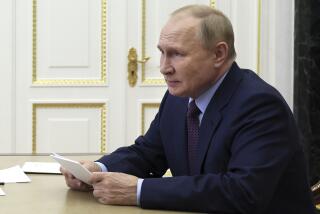KGB Tracking Diplomats With ‘Spy Dust,’ U.S. Says : Step-up in Agents’s Use Protested
- Share via
WASHINGTON — The KGB has dusted ordinary objects like doorknobs and steering wheels with an invisible “spy dust” that may cause cancer in order to track the movements and contacts of American diplomatic personnel in Moscow, the State Department charged today.
The State Department said the invisible tracking agent, known as 5-(4-Nitro Phenyl)-2 4-Pentadiene-1-AL, or NPPD, is a mutagen--a chemical agent that alters living cells and can be carcinogenic in humans.
The United States, which said the practice has been going on for years but increased dramatically in recent months, delivered a strong protest to the Soviet government Monday and demanded that use of the chemical be stopped immediately, the State Department said.
Medical Team Formed
A medical task force under the direction of the National Institutes of Health and the Environmental Protection Agency has been formed and will go to Moscow to investigate the potential hazard, the department said.
“There is no evidence to date that any embassy personnel have suffered ill effects due to exposure to tracking agents,” a department statement said, but laboratory tests may take years to determine if a serious hazard exists.
The U.S. Embassy in Moscow held a series of briefings today, advising officials, their families, and private Americans of the situation.
The matter is regarded as serious enough to be on the agenda of the September meetings between Secretary of State George P. Shultz and Soviet Foreign Minister Eduard Shevardnadze, the department said.
Possible Summit Topic
In Los Angeles, White House spokesman Larry Speakes said it is “entirely possible” the issue will be raised by President Reagan during his November summit with Soviet leader Mikhail S. Gorbachev.
Speakes said Reagan received a detailed report Monday and approved the protest made to the Soviets.
“This is a serious matter,” he said. “Whatever the KGB has done, certainly the political leadership of the Soviet Union is responsible for the conduct of their security services.”
The chemical tracking agent, a U.S. official said, was used by the Soviets at least once in the United States and “that Soviet authorities for a number of years have used chemical substances to monitor the activities of employees of the U.S. Embassy in Moscow.”
Used on Journalists
It is also presumed to have been used against private Americans in Moscow, including journalists, who have been in contact with dissidents.
The official said he could not discuss operational questions, including the possible damage done to U.S. intelligence.
“The substances in question, which have been applied indirectly to embassy personnel, leave deposits on the person or possessions of people with whom they have had contact,” the statement said. It can be detected only through chemical analysis, the department said.
Anyone coming in contact with the chemical would leave minute traces on other objects and people touched later. Officials said such traces would allow Soviet intelligence agents to easily verify contacts made by the Americans.
First Used in ‘70s
Use of the tracking agent by the Soviets first was detected in the 1970s, the State Department said, but it was used rarely and in tiny quantities, not enough to be seen as a possible health hazard.
But the official said that early this summer the powder suddenly began to appear in Moscow in much larger quantities--dusted on such things as doorknobs, steering wheels or car seats--raising the possibility that Americans could be harmed.
In 1983, the United States strongly protested to the Soviets when a high level of microwaves was detected, aimed at the embassy in what appeared to be an eavesdropping operation by the KGB. After the public protest, the microwave bombardment apparently halted.
More to Read
Sign up for Essential California
The most important California stories and recommendations in your inbox every morning.
You may occasionally receive promotional content from the Los Angeles Times.













